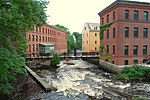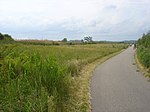John F. Kennedy Presidential Library and Museum

The John F. Kennedy Presidential Library and Museum is the presidential library and museum of John Fitzgerald Kennedy (1917–1963), the 35th president of the United States (1961–1963). It is located on Columbia Point in the Dorchester neighborhood of Boston, Massachusetts, next to the University of Massachusetts at Boston, the Edward M. Kennedy Institute for the United States Senate, and the Massachusetts Archives and Commonwealth Museum. Designed by the architect I. M. Pei, the building is the official repository for original papers and correspondence of the Kennedy Administration, as well as special bodies of published and unpublished materials, such as books and papers by and about Ernest Hemingway. The library and museum is part of the Presidential Library System, which is administered by the Office of Presidential Libraries, a part of the National Archives and Records Administration (NARA).The library and Museum were dedicated in 1979 by President Jimmy Carter and members of the Kennedy family. It can be reached from nearby Interstate 93 or via shuttle bus or walk from the JFK/UMass stop on the Red Line of Boston's MBTA system.
Excerpt from the Wikipedia article John F. Kennedy Presidential Library and Museum (License: CC BY-SA 3.0, Authors, Images).John F. Kennedy Presidential Library and Museum
Boston HarborWalk, Boston Dorchester
Geographical coordinates (GPS) Address Website External links Nearby Places Show on map
Geographical coordinates (GPS)
| Latitude | Longitude |
|---|---|
| N 42.315891666667 ° | E -71.034086111111 ° |
Address
John F. Kennedy Presidential Library and Museum
Boston HarborWalk
02125 Boston, Dorchester
Massachusetts, United States
Open on Google Maps







